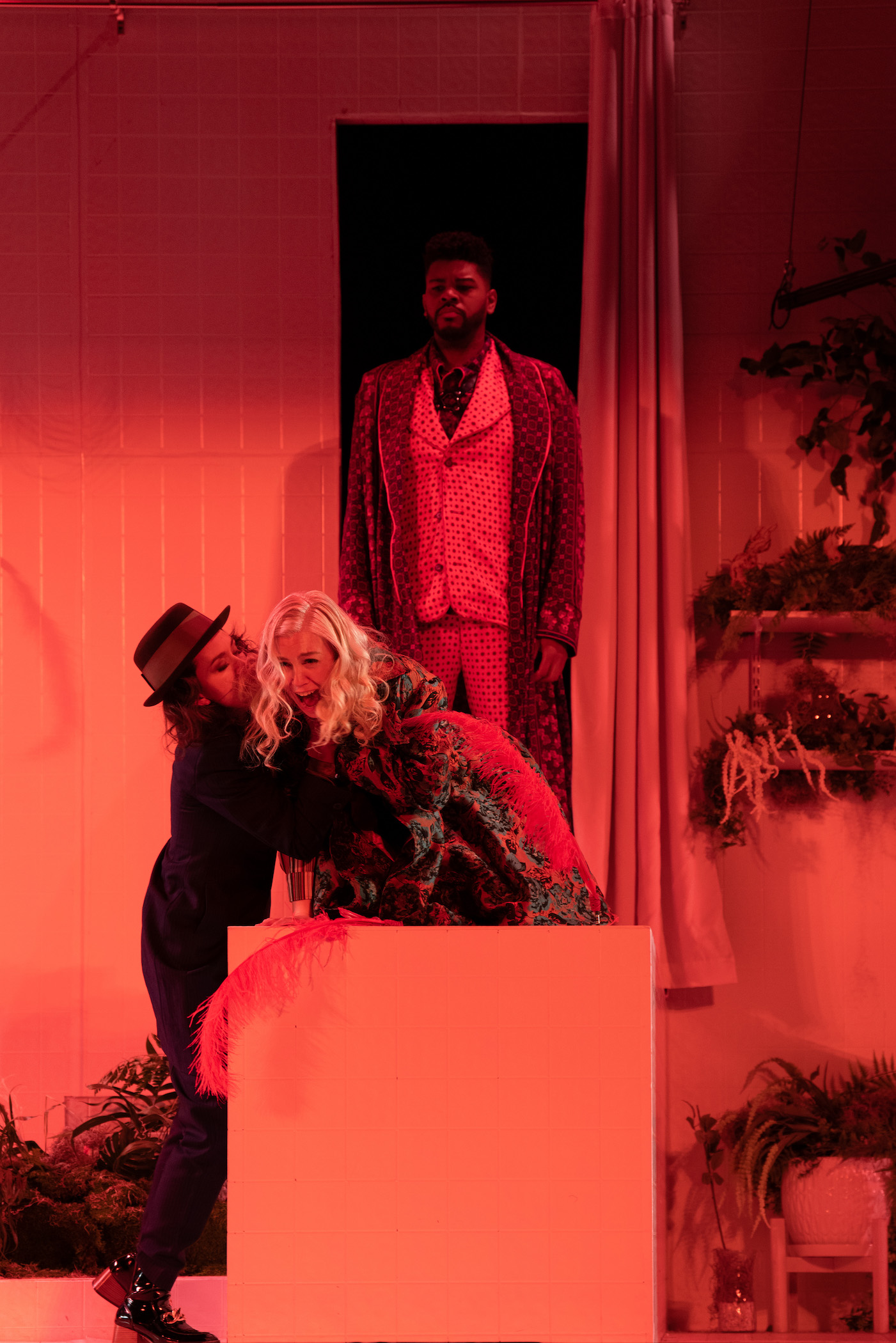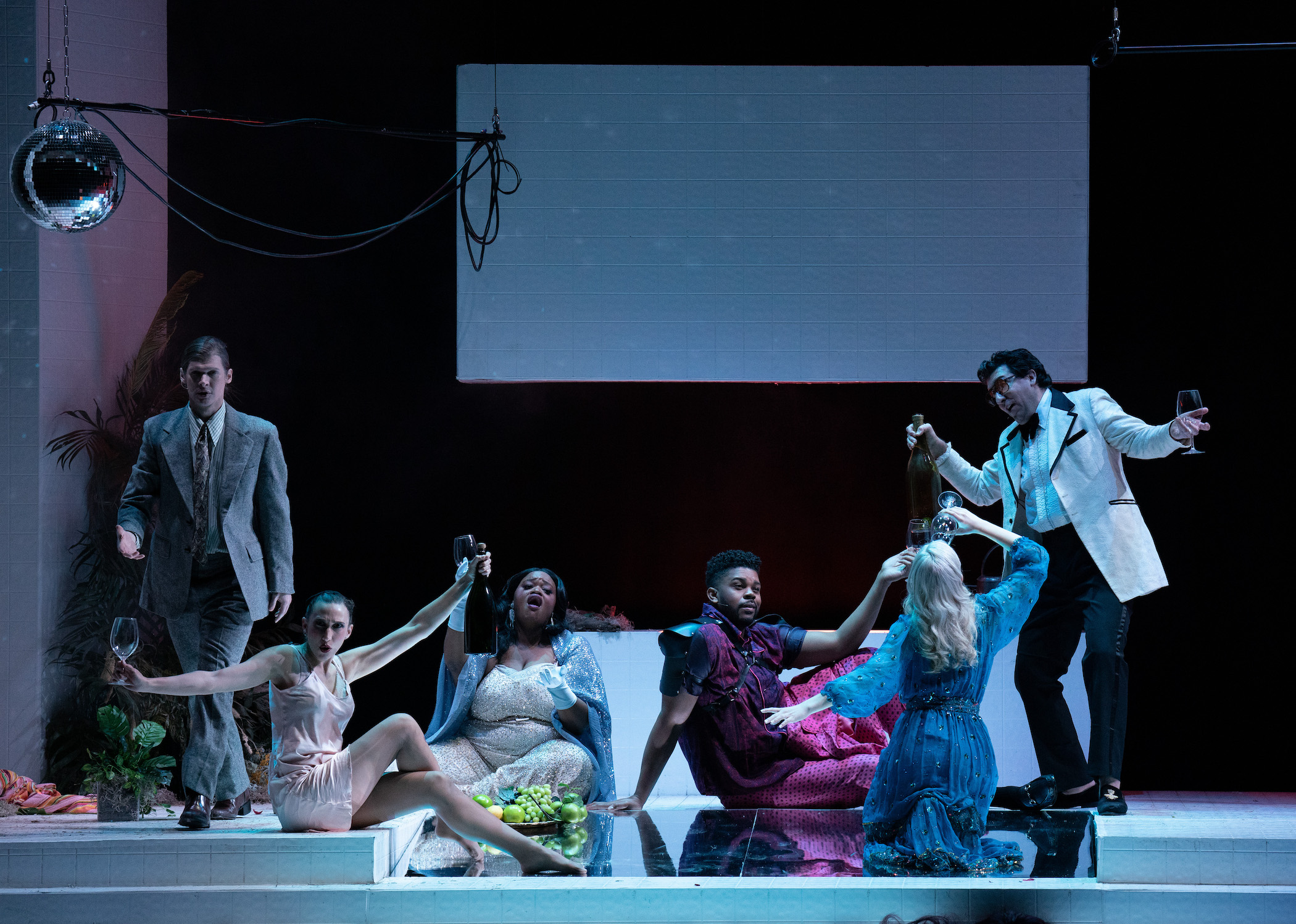Comments
GELFAND’S WORLD - Writing about the recent Long Beach Opera production of The Romance of the Rose turns out to be hard, but in a good way. There is so much there to talk about. It is, first of all, a bright and shiny rendition of a 13th century love poem with a modern twist, and it is written using an eclectic use of modern classical music (as described by one of the musicians) and it features a stunningly talented cast of young American singer/actors.
What Romance of the Rose does not do is follow the standard plot elements in classical opera: You know: Boy gets girl. Boy loses girl. Boy gets girl back. They all die dramatically while managing to hit their high notes. Not to disparage the greats of classical opera. There are lots of reasons people still pack the opera houses to see La Boheme a century after its debut.
But perhaps there is room for something new and different, and Long Beach Opera loves trying out all the new/different pieces along with some older pieces that don't get performed enough.
So there are no duels at swords point here. Instead, we see how the young man and the young woman find each other in dreams, all the while questioning the reality of what they are going through. Their thoughts and yearnings are criticized by the characters Lady Reason and Shame, and all the while, the god of Love, along with the characters Idleness and Pleasure, get their two cents worth in.
The plot and scenery swirl around in an operatic attempt to create a dreamscape which is inhabited by unearthly song, then by something getting a little closer to show tunes, and finally by the guilt-giving screeching (artistically and beautifully sung) of the lady known as Shame.
So for the most part, it was musically beautiful, and when it was not quite so beautiful it was interesting and sort of distracting.
What particularly caught my attention were two things. The first is that the cast was populated by young, attractive people who did not look like your typical 50-ish opera star trying to play the doomed 17-year-old or the brave, fit, warrior. You've got to admit that the LBO managed to push this about as far as you can go when they featured a young woman who is currently finishing her undergraduate degree at UCLA as the female lead listed in the notes as The Lover. And a remarkably talented performer she is, having the looks and abilities of a professional dancer (she is) combined with a pretty good mezzo soprano voice.
Opera, or to use Richard Wagner's term Music Drama, is the highest form of art. It's not just that it incorporates elements of all other art forms -- words, music, visual effects -- but that in its best nights, it meshes them into something deeper and more emotionally effective. The Long Beach Opera (LBO) performance of Romance of the Rose was one such experience. And at the same time it wandered off the standard path. Instead, we got a musical comedy with elements of sadness and elements of gladness, and underlying it all some attempt at philosophy. What is Love might be the theme, or it might be What is Reality -- Is our Life's Experience Really Real?
To carry out this task, the plot of Romance of the Rose involves a young man and a young woman (in the old silent film days of Harold Lloyd, they would be called The Boy and The Girl) and they have dreams. And in dreaming they are confronted by characters who question their thoughts and overall approaches to life. There is Lady Reason, played by the astounding Anna Schubert, who combines the body of a professional ice skater with a remarkably clear and beautiful voice. There is another attractive figure in Shame, played by Laurel Irene, who has another fetching voice with remarkable range. And carrying the show both comedically and vocally is that other young talent, Tivoli Treloar as The Lover with the voice and mannerisms of a valley girl accompanied by a professional operatic voice . She is first introduced to us as a volunteer who is recruited from the audience, stepping out of an aisle seat near the front. She looks like a combination of Daisy Mae and that westside college girl.
But enough of my own verbal ramblings. A picture of Tivoli as The Lover (to the right) and of Laurel Irene as Shame (to the left) gives you and idea of the visual approach the LBO took.

If you are going to play off the girl and the boy, you need The Boy, and LBO has succeeded masterfully by featuring Lucas Steele. The LBO staff referred to Steele as a Broadway actor (which he is) who is also an accomplished singer (as they also do on Broadway). Steele has the ability to hit high notes and work in a higher register, which he does quite a bit in this production. And unlike a lot of accomplished opera singers, he looks the part of young and thin, as the photo shows, where Steele is on the far left and Anna Schubert as Reason is next to him.

The music
It's hard to write about LBO's The Romance of the Rose in the usual way. Opera audiences are used to hearing lyrical works with harmony and scales and romantic tunes. (Remember Amadeus?) Instead, composer Kate Soper has combined a variety of approaches. When asked, one of the orchestra members defined the musical style as modern classic, and eclectic. This will have to do, as there were moments which sounded like classical opera in a new style, and moments (particularly when voiced by Shame) that were renditions of fury and contempt. She certainly got the fury part.
I'd like to take a moment to refer to one scene which I particularly enjoyed. Lady Reason is trying to convince Tivoli (as The Lover) that love is just a mechanical process involving chemicals and synapses, and to be discounted compared to cool reason. In what might be called an aria, or perhaps an extended song, Schubert refers to dopamine and acetylcholine and the workings of the brain. The audience found this perfectly funny; as a working biologist, I found it understandable and even a pretty good argument. (I'm not intimidated by words like acetylcholine.) The score was the most tonal (some would call it "musical") and rhythmic, and I thoroughly enjoyed it. And then it occurred to me that Lady Reason resembles two characters from modern television shows, one being Amy, the hyper-nerd from Big Bang Theory, and the other being Dr Maura Isles from the detective drama Rizzoli and Isles. In each case, the character does not mind using the words of her craft to explain things, even as the people around her look confused and demand that she translate her words into common English. But Anna Schubert did it all with a remarkable voice and with ballet-like moves.
The opera includes a lot of questioning in which the characters (caught in their dreams) wonder at the reality of what is, after all, not real. The text ends with the male lead wondering whether any of it is real. At some level, that theme truly fits the word sophomoric, as in the sort of musing that happens in the freshman dormitory. But when done well, and related by believable characters, it's OK to do sophomoric. What is reality, indeed? It's a fair enough question, and if dozens of religions and legions of philosophy professors haven't found a convincing answer, then the opera stage is as good as any, I would guess.
One last thing. From the get go, this opera reminds us that the LBO has no respect for the fourth wall -- as in the male lead walks down into the aisle to collect his volunteer (Tivoli) and pointedly asks her to do a mic check with him. No fooling around with standard operatic conventions. And the volunteer, as The Lover, goes back and forth from her dreamlike operatic voice to her straightforward college girl voice. At one point, she even says, "I want to go back to my seat." The production shifted back and forth from old-time surrealism to comedic-break the fourth wall-natural talk, and the audience laughed heartily as we went along.
One other point. The title Romance of the Rose refers to some peculiar medieval concept of the lover falling in love with an actual rose, which also represents a human lover. In this performance, Tivoli at one point goes into the westside college girl voice and marvels rather sarcastically, "I'm in love with a plant," or something like that, and another character points out that she loves an inanimate object. The audience enjoyed this breaking of the fourth wall, which also served to underscore the questioning of reality while simultaneously making fun of operatic conventions.
As we've mentioned at various times, the LBO puts on performances in various venues ranging from the Long Beach Terrace Theater to a dockside warehouse. This time, The Romance of the Rose was performed in the Warner Grand Theater in San Pedro. There is a story to be told, because the WGT is an old time movie house (opened in 1931 for the new-fangled sound films but with the backup ability to provide for live performances. Like so many old theaters, the WGT was going broke as the television era took hold, and it might have been turned into a flea market or rebuilt as a parking lot. But in the nick of time, it was purchased by the City of Los Angeles and has been under the control of the Cultural Affairs Department. The punchline to this story is that the WGT used to have acoustic issues (a polite way of saying that the sound was always muddy) but that has been fixed, and at the opera the other night, it was crisp and understandable. Good going.
(Bob Gelfand writes on science, culture, and politics for CityWatch. He can be reached at [email protected].)






